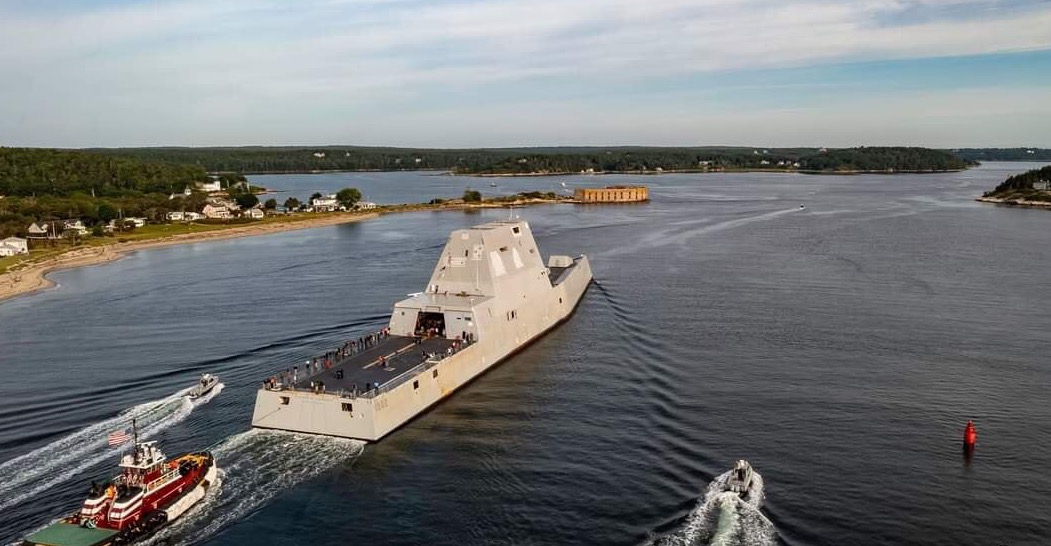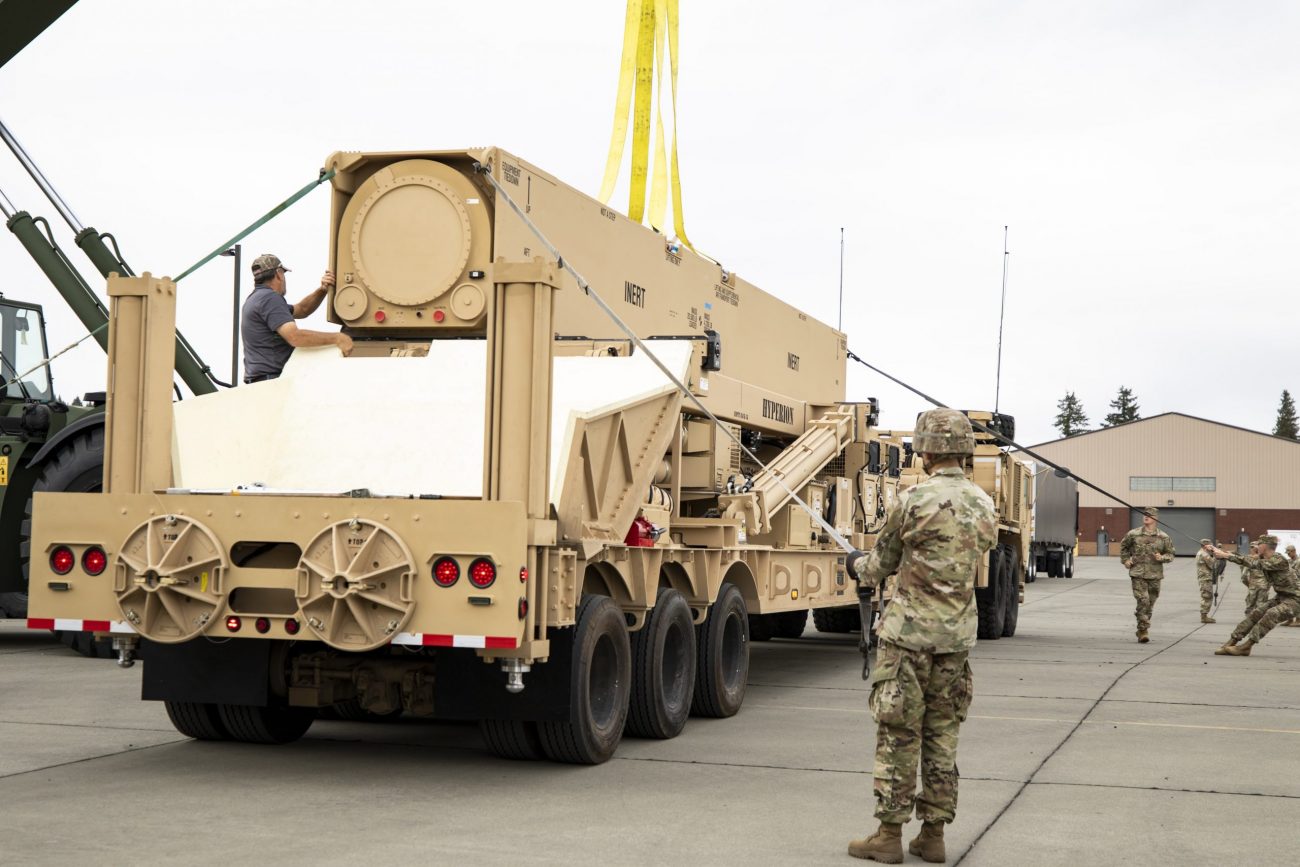Russia’s use of the ‘Kinzhal’ hypersonic missile in Ukraine, the first-ever used in combat, has shaken the United States. The US Navy, which has lagged behind Russia in developing hypersonic weapons, is looking to deploy its first on a warship in early 2023, the Associated Press reported.
Ukraine War – British-NATO Military Convoy Carrying ‘Nuclear Warheads’ Passes Through Glasgow?
The US is competing with Russia and China to develop these weapons, which travel eight times faster than the speed of sound, making it difficult to shoot down due to their maneuverability. Before hitting the target, the weapon being developed by the US would launch like a ballistic missile and deploy a hypersonic glide vehicle.

Bath Iron Works, a division of General Dynamics, has reportedly begun engineering and design work on the alterations required to deploy the armament system aboard three Zumwalt-class destroyers in Maine. According to the US Navy, the work on the missiles would begin in October 2023 at an unnamed shipyard.
Due to a design flaw that works to the Navy’s benefit, the three stealthy Zumwalt-class destroyers that will be armed with the new weapons will have plenty of room to accommodate them.
‘Pacifist’ Germany’s Massive $110B Military Budget – What Triggered Berlin To Rethink Its National Security Strategy
The ships were designed around a gun system that was expected to hit targets 90 miles (145 kilometers) away using GPS-guided, rocket-boosted rounds. The Navy canceled the system because the bullets were too expensive, leaving each ship with a worthless loading system and a pair of 155-mm cannons disguised in angular turrets.
According to Bryan Clark, a defense expert at the Hudson Institute, the modification of all three ships would cost more than $1 billion but will provide the Navy with a new capability for the tech-laden, electric-drive ships that already cost the Navy $23.5 billion.

The Navy plans to deploy the weapons on destroyers by 2025 and Virginia-class nuclear-powered attack submarines by 2028, according to the Navy.
Russia has claimed that it has ballistic missiles that can deploy hypersonic glide vehicles as well as hypersonic cruise missiles. It possesses the most advanced and lethal hypersonic weapons, including an advanced and lethal Avangard, Tsirkon, and Kinzhal. China, too, uses the DF-17 to transport its hypersonic glide vehicle.
Both of the US’ adversaries have hypersonic weapons, the US lags behind in this significant military technology.
Why is the US afraid of hypersonic weapons?
Any weapon that travels faster than Mach 5, or five times the speed of sound, is classified as a hypersonic weapon. That’s roughly 3,800 miles per hour (6,100 kph). Intercontinental ballistic missiles are significantly more powerful than hypersonic missiles, but they follow a predetermined path that allows them to be intercepted.
Shocking Images Of Chinese Military Occupation Of Three Islands In The South China Sea Rings Alarm Bells In The US
Existing missile defense systems in the United States, such as the Navy’s Aegis, would struggle to intercept such objects due to their agility, which makes their movement unpredictable and gives little time to react.

When compared to traditional ballistic missile trajectories, which follow a set trajectory, they are designed to be able to make rapid and unexpected changes along their flight routes. Due to their mobility, as well as their high speed and general flight profile, they are extremely difficult to identify and track, especially with sensors designed for conventional ballistic missiles, as EurAsian Times had previously reported.
MDA and the US Space Force have not indicated how far they can monitor hypersonic weapons or how close the US is to intercepting one. During the cruise phase, hypersonic missiles can fly low and move to avoid radar detection and strike high-value targets.
The United States is struggling to catch up because it avoided investing in new technology, with only a fraction of the 10,000 people working on the program in the 1980s, according to US Rep. Jim Cooper, a Tennessee Democrat who chairs a program-monitoring subcommittee. If we want to achieve parity, we’ll have to invest more money, time, and skill than we are right now, he said.
The Russian invasion of Ukraine serves as a backdrop for the Pentagon’s budget request later this month, which lays out its aspirations for hypersonic and other military systems.
After hesitating in the past due to technological challenges, the US has shifted its focus to hypersonic weapons. In the meantime, the adversaries maintained their research and development.
Late in December, Russia launched a salvo of Zircon (Tsirkon) hypersonic cruise missiles, signaling the end of weapon testing. But, according to Loren Thompson, a defense analyst at the Lexington Institute, Russia may be inflating the capacity of such superweapons to compensate for weaknesses in other areas. Russia doesn’t have many of the weapons at the moment, and it’s uncertain how effective they are, he said.
Deployment against China
The warships with hypersonic missiles onboard would be stationed in the Pacific Ocean as a deterrent to China if it became emboldened by Russia’s attack on Ukraine and decided to strike Taiwan, according to Clark.
The US has also reportedly been testing its Long Range Hypersonic Weapon system, which is a land-based surface to surface hypersonic weapon to be deployed in Guam for Taiwan’s defense. However, it does not officially possess a hypersonic weapon in its inventory as of now.

The US quest to develop and deploy hypersonic weapons has never been free of hurdles. The Air Force’s efforts to acquire its first hypersonic missile recently met a fresh stumbling block after a series of test failures earlier. In a new fiscal 2022 omnibus spending measure, congressional appropriators trimmed funding for the service’s main hypersonic weapons program, as previously reported by EurAsian Times.
The $161 million US Air Force plan for the procurement of AGM-183A Air-Launched Rapid Response Weapon was removed from the compromise budget bill, which was proposed and passed on March 9.

On the contrary, China has made great advancements in hypersonic technology testing and development. It was earlier reported that the Chinese glide vehicle discharged a sub-munition into the South China Sea after firing a hypersonic missile that circled the globe and astonished the US.
On the other hand, unfortunately, the third test flight of the US AGM-183A Air-Launched Rapid Response Weapon, like the previous two, was a failure. The missile failed to dislodge from the wing of a B-52H bomber in a recent test. The failure of the American tests provided China with an opportunity to criticize the US hypersonic program while flaunting its own.
However, the Russian firing of a hypersonic weapon, China’s relentless efforts at advancing its hypersonic program and the tensions in the Indo-Pacific region where the US is a major stakeholder is expected to bolster the US efforts at fielding a hypersonic weapon in accordance with the deadline it has set for itself.
- Contact the author at sakshi.tiwari9555@gmail.com
- Follow EurAsian Times on Google News




